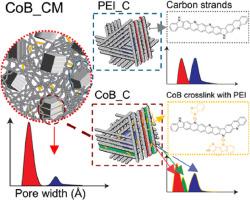Ultramicroporous carbon molecular sieve membranes via co-pyrolysis of cobalt-2,6-bis(2-benzimidazolyl) pyridine and polyetherimide for enhanced gas separations
IF 11.6
2区 材料科学
Q1 CHEMISTRY, PHYSICAL
引用次数: 0
Abstract
Carbon molecular sieve membranes (CMSM) have been extensively researched for industrial gas separation owing to their high permeance, tailored selectivity, and stability in corrosive and high-temperature environments. In recent years, CMSM development has focused on modifying the structure of carbon precursors to improve permeability. In this study, we designed a new thin film CMSM incorporating cobalt-2,6-bis(2-benzimidazolyl) pyridine (CoB) dopant within the polyetherimide (PEI) precursor on tubular α-alumina substrates. CoB-doped CMSM (CoB_CM) with systematic CoB concentrations (0–10 w/w %) were investigated to understand the co-pyrolysis effect of CoB on the PEI-derived CMSM microstructure and gas transport (single gas permeation and binary gas separation) over the course of 10 days, with an average membrane thickness of 10 μm. These were fabricated using a vacuum-assisted, dip-coating process followed by vacuum pyrolysis at 600 °C. The binary gas separation (H2/CH4, 50/50 vol%) tests further demonstrate the enhanced stability and separation performance of the 1CoB_CM membrane over the PEI_CM membrane, producing H2 permeability of 2800 Barrer (282.2 ± 0.35 GPU) and H2/CH4 selectivity of 234 ± 2. These results suggest that CoB can effectively tune the micropore architecture of the CMSM, particularly further enhancing ultramicroporosity and gas transport of smaller gases, thereby offers a promising strategy of developing high-performance carbon molecular sieving membranes for challenging gas separations.

超微孔碳分子筛膜通过钴-2,6-双(2-苯并咪唑)吡啶和聚醚酰亚胺共热解进行强化气体分离
碳分子筛膜(CMSM)由于其高渗透性、定制选择性和在腐蚀性和高温环境中的稳定性,在工业气体分离中得到了广泛的研究。近年来,CMSM的发展主要集中在改变碳前驱体的结构以提高渗透率。在这项研究中,我们设计了一种新的薄膜CMSM,在管状α-氧化铝衬底上的聚醚酰亚胺(PEI)前驱体中加入钴-2,6-双(2-苯并咪唑)吡啶(CoB)掺杂剂。在平均膜厚为10 μm的条件下,研究了CoB掺杂CMSM (co_cm)在系统CoB浓度(0-10 w/w %)下的共热解过程,以了解CoB对pei衍生CMSM微观结构和气体输运(单气体渗透和二元气体分离)的影响。这些材料采用真空辅助浸涂工艺,然后在600°C下真空热解制备。二元气体分离(H2/CH4, 50/50 vol%)实验进一步证明了1CoB_CM膜比PEI_CM膜具有更高的稳定性和分离性能,H2渗透率为2800 Barrer(282.2±0.35 GPU), H2/CH4选择性为234±2。这些结果表明,CoB可以有效地调整CMSM的微孔结构,特别是进一步增强小气体的超微孔隙度和气体输运,从而为开发高性能碳分子筛膜提供了一个有前途的策略,用于具有挑战性的气体分离。
本文章由计算机程序翻译,如有差异,请以英文原文为准。
求助全文
约1分钟内获得全文
求助全文
来源期刊

Carbon
工程技术-材料科学:综合
CiteScore
20.80
自引率
7.30%
发文量
0
审稿时长
23 days
期刊介绍:
The journal Carbon is an international multidisciplinary forum for communicating scientific advances in the field of carbon materials. It reports new findings related to the formation, structure, properties, behaviors, and technological applications of carbons. Carbons are a broad class of ordered or disordered solid phases composed primarily of elemental carbon, including but not limited to carbon black, carbon fibers and filaments, carbon nanotubes, diamond and diamond-like carbon, fullerenes, glassy carbon, graphite, graphene, graphene-oxide, porous carbons, pyrolytic carbon, and other sp2 and non-sp2 hybridized carbon systems. Carbon is the companion title to the open access journal Carbon Trends. Relevant application areas for carbon materials include biology and medicine, catalysis, electronic, optoelectronic, spintronic, high-frequency, and photonic devices, energy storage and conversion systems, environmental applications and water treatment, smart materials and systems, and structural and thermal applications.
 求助内容:
求助内容: 应助结果提醒方式:
应助结果提醒方式:


